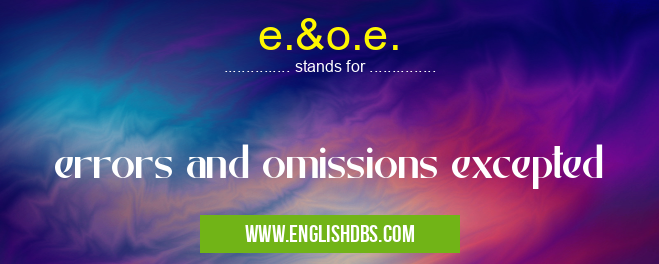What does E.&O.E. mean in GENERAL
Errors and Omissions Excepted (E&OE) is an abbreviation which is widely used in the business world. It is used to denote that a document or statement contains errors that have been made inadvertently and are not intentionally included. This acronym first came into use in the legal profession in the late 18th century, but it has since been increasingly adopted for wider usage. The phrase “errors and omissions excepted” can be seen on many documents, including invoices, contracts, terms & conditions, warranties, insurance policies, etc.

e.&o.e. meaning in General in Business
e.&o.e. mostly used in an acronym General in Category Business that means errors and omissions excepted
Shorthand: e.&o.e.,
Full Form: errors and omissions excepted
For more information of "errors and omissions excepted", see the section below.
Meaning
This unique combination of words carries a lot of meaning. It means that any errors or omissions that may have occurred in any document or statement should not be considered intentional acts of deception or misrepresentation. Rather, these are honest mistakes resulting from human error or technical failures. In other words, buyers should not hold sellers legally accountable for these unnoticed mistakes.
Common Uses
The E&OE acronym is most commonly used when drafting legal contracts and issuing invoices or purchase orders between two parties. By adding this phrase at the bottom of the document, sellers signify their willingness to cooperate and accept responsibility if there are any mistakes in the stated information which they may not have noticed earlier on. Similarly, buyers can take comfort from this clause as it protects them from legal liability if any errors go unnoticed at the time of signing the contract.
Benefits
The primary benefit of using E&OE is that it allows buyers and sellers to continue with their business without worrying too much about minor details like spelling mistakes or wrong product descriptions that may have been included by accident recently. This provides peace of mind for both parties knowing that they are protected if unintentional errors do occur along the way. Additionally, it reduces uncertainty about who is liable for such mistakes as well as time-consuming litigation matters during disputes over minor details such as incorrect wording in a contract.
Essential Questions and Answers on errors and omissions excepted in "BUSINESS»GENERALBUS"
What do you mean by e.&o.e.?
"E.&o.e." stands for "Errors and Omissions Excepted". It is commonly used to inform customers that mistakes may be made in the information provided, but that the company will not be held liable for any errors or omissions that have occurred
Final Words:
In summary, Errors & Omissions Excepted (E&OE) serves an important purpose in modern business transactions by shielding both parties from legal liability increases uncertainty and lengthy disputes over seemingly small issues such as typographical errors or misordered quantities of products/services provided/requested within a document like an invoice or a purchase order slip.
